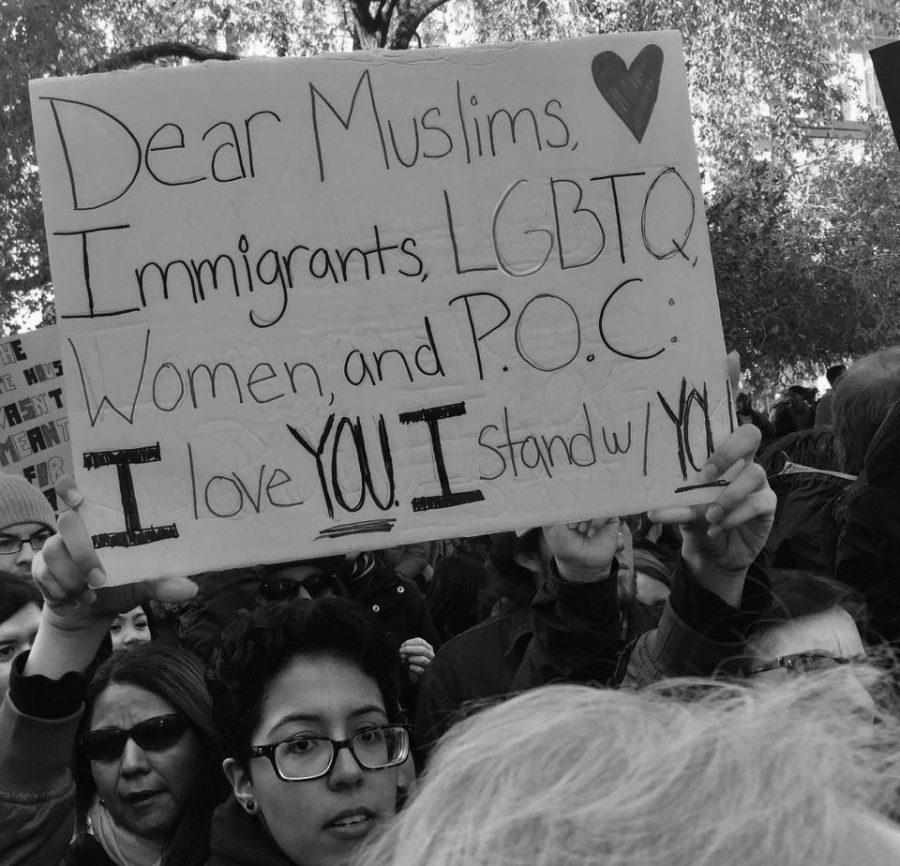Hackley students respond to widespread protests against President-elect Donald Trump
Credit: Bujana Mulosmani
Thousands of protesters stood outside Trump Tower in NYC on November 12.
December 17, 2016
“Dump Trump! This pussy grabs back!,” screamed one woman inciting cheers from fellow protesters. Her outrage and frustration are reflected in the thousands of people surrounding her, carrying signs and shouting irate remarks at Trump Tower, located at Fifth Avenue and 56th Street in Manhattan. On November 12, thousands of protesters in search of comfort marched from 14th Street in Union Square uptown to Donald Trump’s home. Their angry slogans and distressed screams echoed throughout the busy streets eliciting cheers and anxiety from passersby.
Senior Bujana Mulosmani was one of the thousands of protesters gathered before Trump Tower that day. Though at first concerned about her safety, her worries faded with the overwhelming support of the crowd. “It was peaceful the entire way through; people brought their kids and family. It was not violent. We were loud, sure, but definitely peaceful,” said Bujana. “Everyone was so empowered by other people. ‘Her body, her choice’ was by far my favorite chant. Men and women alike chanted this and you felt a sense of affirmation and community.”
Knowing that the protests will not change the election results, Bujana sees them as necessary for the emotional and mental states of the citizens. “After the election, so many people were devastated, especially on the liberal side. Protests serve as a great outlet for a lot of these emotions that people were overwhelmed with,” said Bujana. “This protest was a great way to express our emotions with a lot of people who agreed with them and were just as passionate,” she added.
Junior Sachin Shah understands the dramatic response to Trump’s victory, but disagrees with some actions taken by the protestors. “I think that it is an abomination to the United States of America that liberals who are upset by the results of the election are burning flags, killing people, and violently abusing those who voted for Trump,” said Sachin. “At the same time, the anger is understandable because the election results were not favorable to the majority of Americans,” he continued.
From the Boston Tea Party to the March on Washington for Jobs and Freedom to Standing Rock, the United States is rich with history of protests. In bringing discomfort and starting conversation, these protests foster changes throughout American history, yet many criticize violent protest as a proper means of generating change. Senior Tucker van Eck expressed his respect for peaceful protesters, but feels that violent protesters disrupt communities. “They did that to say that they don’t stand with [Trump] but you don’t have to stand with his ideas,” said Tucker, “but the ideas that they think he stands for will not be able to enforce misogyny or sexual assault. Some of his policies may incite outrage, which is understandable. I felt like [violent protesters were] immature, childish, and unproductive. If anything it didn’t help their cause.”
More than a month later, protests continue on college campuses and in various cities across the United States and the world. Trump’s victory has reportedly elicited negative response internationally, with protests being held in the United Kingdom, Belgium, Israel, and the Philippines.
In response, House Speaker Paul Ryan attempted to ease people’s fears and discontent. “People should really put their minds at ease,” he said on CNN’s State of the Union. “We’re pluralistic, we’re inclusive. That’s the country we are and that’s the country we’ll continue to have.”

